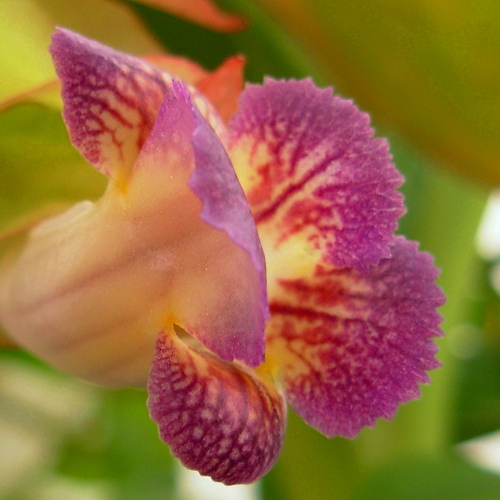Germinating the seeds
When to plant -- Plant them when you receive them for best results. Soil -- Use a well-draining mix. A typical mix is 2 parts potting soil to 1 part perlite (use small- or medium-grade perlite, not coarse-grade). An alternate mix is 1 part perlite to 1 part coir fiber, with some granular fertilizer mixed in. Don't add lime to the mix. Use small pots or cups with have drainage holes. Fill them with the soil mix and place 2 or 3 seeds on top. Then sprinkle a thin layer of long-fibered sphagnum moss (not ground peat moss). This helps retain moisture around the seeds while allowing light to reach them, which aids germination. The proper amount of moss to use is seen in this photo. If you don't have moss, sprinkle some vermiculite, or your soil mix. Then add water until everything is evenly moist (but not fully saturated). Until the seeds sprout, it's important to always keep the surface moist. An easy way to maintain moisture is to enclose the pots in a plastic container or bag. Leave it open slightly to allow some fresh air in. You may need to drip a few drops of water on the surface one or more times a day to keep it moist. Aim to keep the seeds between 65 and 78° F (18-26°C). I have no information about how well they germinate outside that temperature range. I recommend placing a minimum/maximum thermometer near the pots, especially if using a heating mat. Keep them in a bright spot out of direct sun. An LED or fluorescent bulb kept 4 inches (10 cm) away provides the right amount of light (See: "Growing indoors with LED lights"). They tend to sprout between about 6 and 10 weeks after planting. After they sprout, increase the air circulation slightly, and keep them in a bright spot. Protect them from direct sun at least the first month. Watering: After the seedlings are 4 weeks old, you may allow the soil surface to dry out between waterings, but aim to keep the rest of the soil evenly moist most of the time. Never let it dry out completely, but also avoid keeping it constantly soggy, and don't let the pot sit in a tray of water. If your water supply is very high in minerals (= "hard water"), you might need to use bottled water or rainwater. Fertilizing -- For the first 6 weeks, feed weekly with a small amount of diluted liquid fertilizer (1/8 strength). Hydroponic fertilizer is ideal for small seedlings, since it is easily absorbed and complete. After 6 weeks, you may switch to a granular fertilizer that contains micronutrients, or continue feeding weekly with some dilute liquid fertilizer. If the older leaves appear pale/yellowish, the soil may be too dry down in the root zone. If the soil moisture in the root zone is ok, the plant may need more fertilizer.. especially if light levels are high. Climate -- The plant comes from tropical hills, where the climate is mild all year. I have only grown it indoors between 62 and 80 degrees F (17-27 C), and i don't know how well it grows outside that temperature range. It is said to prefer high humidity, but it's grown well for me at 45% humidity. I don't know if it can take much dryer air than that though. If your plants seem to suffer from low humidity indoors, consider using an ultrasonic room humidifier, sold at home improvement stores and some thrift shops. Repotting -- Once your seedlings are at least 1.5 inches tall (4 cm), you may repot them to larger containers. Repot gently to avoid damaging the roots. Repot into a well-draining mix like descibed before. For the first week or two after repotting, shade from sun and give no fertilizer. Insects to watch for -- Look for any insects that you find on your other houseplants. Try using insecticidal soap spray before resorting to harsher chemicals. Pruning -- If your plants happen to get too tall, you may clip the top, which will encourage side branches to form. Happy growing! - Jeff Strange Wonderful Things
|
|||||||||


